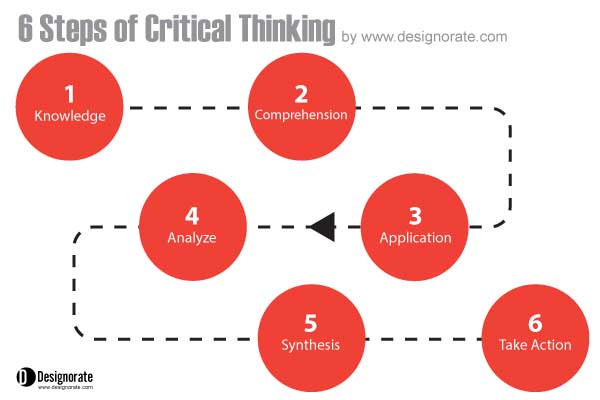6 Steps for Effective Critical Thinking
On a daily basis, we face problems and situations that should be evaluated and solved, and we are challenged to understand different perspectives to think about these situations. Most of us are building our cognitive thinking based on previous similar situations or experiences. However, this may not guarantee a better solution for a problem, as our decision may be affected by emotions, non-prioritized facts, or other external influences that reflect on the final decision. Therefore, critical thinking tends to build a rational, open-mined process that depends on information and empirical evidence.
The National Council for Excellence in Critical Thinking defines critical thinking as an “intellectually disciplined process of actively and skillfully conceptualizing, applying, analyzing, synthesizing, and/or evaluating information gathered from, or generated by, observation, experience, reflection, reasoning, or communication, as a guide to belief and action.” The process tends to help us judge and evaluate situations based on understanding the related data, analyze it, build a clear understanding of the problem, choose the proper solution, and take actions based on the established solution.
The critical thinking process prevents our minds from jumping directly to conclusions. Instead, it guides the mind through logical steps that tend to widen the range of perspectives, accept findings, put aside personal biases, and consider reasonable possibilities. This can be achieved through six steps: knowledge, comprehension, application, analyze, synthesis, and take action. Below is a brief description of each step and how to implement them.

Step 1: Knowledge
For every problem, clear vision puts us on the right path to solve it. This step identifies the argument or the problem that needs to be solved. Questions should be asked to acquire a deep understanding about the problem. In some cases, there is no actual problem, thus no need to move forward with other steps in the critical thinking model. The questions in this stage should be open-ended to allow the chance to discuss and explore main reasons. At this stage, two main questions need to be addressed: What is the problem? And why do we need to solve it?
Step 2: Comprehension
Once the problem is identified, the next step is to understand the situation and the facts aligned with it. The data is collected about the problem using any of the research methods that can be adopted depending on the problem, the type of the data available, and the deadline required to solve it.
Step 3: Application
This step continues the previous one to complete the understanding of different facts and resources required to solve the problem by building a linkage between the information and resources. Mind maps can be used to analyze the situation, build a relation between it and the core problem, and determine the best way to move forward.
Step 4: Analyze
Once the information is collected and linkages are built between it the main problems, the situation is analyzed in order to identify the situation, the strong points, the weak points, and the challenges faced while solving the problem. The priorities are set for the main causes and determine how they can be addressed in the solution. One of the commonly used tools that can be deployed to analyze the problem and the circumstances around it is the cause effect diagram, which divides the problem from its causes and aims to identify the different causes and categorize them based on their type and impact on the problem.
Step 5: Synthesis
In this stage, once the problem is fully analyzed and all the related information is considered, a decision should be formed about how to solve the problem and the initial routes to follow to take this decision into action. If there are number of solutions, they should be evaluated and prioritized in order to find the most advantageous solution. One of the tools that contribute choosing the problem solution is the SWOT analysis that tends to identify the solution’s strength, weakness, opportunity, and threats.
Step 6: Take Action
The final step is to build an evaluation about the problem that can be put into action. The result of critical thinking should be transferred into action steps. If the decision involves a specific project or team, a plan of action could be implemented to ensure that the solution is adopted and executed as planned.
The critical thinking method can be adopted to replace emotions and perusal biases when trying to think about a situation or a problem. The time for adopting critical thinking varies based on the problem; it may take few minutes to number of days. The advantage of deploying critical thinking is that it contributes to widening our perspectives about situations and broadening our thinking possibilities. However, these steps should be translated into a plan of action that ensures that the decided resolution is well achieved and integrated between all the involved bodies.






